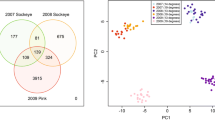Abstract
Novel molecular based methods are being developed to study changes in gene expression in wildlife exposed to anthropogenic chemicals. Gene arrays, in particular, are useful tools that can be used to simultaneously monitor hundreds to thousands of genes within a single experiment, giving an investigator the ability to determine how exposure affects multiple metabolic pathways. These methods are thought to be both sensitive and able to reveal biochemical mechanisms of action. A largemouth bass (LMB) array containing 132 genes has been designed to study the impact of gene expression in male fish exposed to 17-β estradiol or to the compounds 4-nonylphenol (4-NP) or 1,1-dichloro-2, 2-bis (p-chlorophenyl) ethylene (p,p′-DDE). The results of these experiments demonstrate distinct gene expression patterns in LMB exposed to these compounds.
Similar content being viewed by others
References
Arukwe, A., Kullman, S.W., Hinton, D.E. (2001). Differential biomarker gene and protein expressions in nonylphenol and estradiol-17 beta treated juvenile rainbow trout (Oncorhynchus mykiss). Comp. Biochem. Physiol. C Toxicol. Pharmacol. 129, 1-10.
Augereau, P., Miralles, F., Cavailles, V., Gaudelet, C. and Parker, H. Rochefort, H. (1994). Characterization of the proximal estrogen-responsive element of human cathepsin D gene. Mol. Endocrinol. 8, 693-703.
Baker, V.A. (2001). Endocrine disrupters-testing strategies to assess human hazard. Toxicology In Vitro 15, 413-19.
Bowman, C.J., Kroll, K.J., Hemmer, M.J., Folmar, L.C. and Denslow, N.D. (2000). Estrogen-induced vitellogenin mRNA and protein in sheepshead minnow (Cyprinodon variegatus). Gen. Comp. Endocrinol. 120, 300-13.
Bowman, C.J., Kroll, K.J., Gross, T.G. and Denslow, N.D. (2002). Estradiol-induced gene expresion in largemouth bass (Micropterus salmoides). Mol. Cell. Endocrinol. 196, 67.
Cavailles, V., Augereau, P. and Rochefort, H. (1991). Cathepsin D gene of human MCF7 cells contains estrogen-responsive sequences in its 5′ proximal flanking region. Biochem. Biophys. Res. Commun. 174, 816-24.
Celius, T., Matthews, J.B., Giesy, J.P. and Zacharewski, T.R. (2000). Quantification of rainbow trout (Oncorhynchus mykiss) zona radiata and vitellogenin mRNA levels using real-time PCR after in vivo treatment with estradiol-17 beta or alpha-zearalenol. J. Steroid Biochem. Mol. Biol. 75, 109-19.
Denslow, N.D., Bowman, C.J., Ferguson, R.J., Lee, H.S., Hemmer, M.J. and Folmar, L.C. (2001). Induction of gene expression in sheepshead minnows (Cyprinodon variegatus) treated with 17-β-estradiol, diethylstilbestrol or ethinylestradiol: the use of mRNA fingerprints as an indicator of gene regulation. Gen. Comp. Endocrinol. 121, 250-60.
Folmar, L.C., Hemmer, M., Hemmer, R., Bowman, C., Kroll, K. and Denslow, N.D. (2000). Comparative estrogenicity of estradiol, ethinyl estradiol and diethylstilbestrol in an in vivo, male sheepshead minnow (Cyprinodon variegatus), vitellogenin bioassay. Aquatic Toxicol. 49, 77-88.
Gaido, K.W., Leonard, L.S., Lovell, S., Gould, J.C., Babai, D. and Portier, C.J. et al. (1997). Evaluation of chemicals with endocrine modulating activity in a yeast-based steroid hormone receptor gene transcription assay. Toxicol. Appl. Pharmacol. 143, 205-12.
Larkin, P., Folmar, L.C., Hemmer, M.J., Poston, A.J. and Denslow, N.D. (2003). Expression profiling of estrogenic compounds using a sheepshead minnow cDNA macroarray. EHP, Toxicogenomics. 111, 29-36.
Larkin, P., Sabo-Attwood, T., Kelso, J. and Denslow, N.D. (2002). Gene expression analysis of largemouth bass exposed to estradiol, nonylphenol, and p,p′-DDE. Comp. Biochem. Physiol. B. Biochem Mol. Biol. 133, 543-557.
Legler, J., van den Brink, C.E., Brouwer, A., Murk, A.J., van der Saag, P.T., Vethaak, A.D. and van der, B.B. (1999). Development of a stably transfected estrogen receptor-mediated luciferase reporter gene assay in the human T47D breast cancer cell line. Toxicol. Sci. 48, 55-66.
Loomis, A.K. and Thomas, P. (1999). Binding characteristics of estrogen receptor (ER) in Atlantic croaker (Micropogonias undulatus) testis: different affinity for estrogens and xenobiotics from that of hepatic ER. Biol. Reprod. 61, 51-60.
Nimrod, A.C. and Benson, W.H. (1996). Environmental effects of alkylphenol ethoxylates. Crit. Rev. Toxicol. 26, 335-64.
Nimrod, A.C. and Benson, W.H. (1997). Xenobiotic interaction with and alteration of channel catfish estrogen receptor. Toxicol. Appl. Pharmacol. 147, 381-90.
O'Connor, J.C., Frame, S.R., Davis, L.G. and Cook, J.C. (1999). Detection of the environmental antiandrogen p,p-DDE in CD and long-evans rats using a tier I screening battery and a Hershberger assay. Toxicol. Sci. 51, 44-53.
Petit, F., Le Goff, P., Cravedi, J.P., Valotaire, Y. and Pakdel, F. (1997). Two complementary bioassays for screening the estrogenic potency of xenobiotics: recombinant yeast for trout estrogen receptor and trout hepatocyte cultures. J. Mol. Endocrinol. 19, 321-35.
Sabo-Attwood, T., Kroll, K.J. and Denslow, N.D. Differential expression of estrogen receptor isotypes alpha, beta, and gamma during largemouth bass reproduction. Mol. Cell. Endocrinol. (in print).
Sohoni, P. and Sumpter, J.P. (1998). Several environmental oestrogens are also anti-androgens. J. Endocrinol. 158, 327-39.
Thorpe, K.L., Hutchinson, T.H., Hetheridge, M.J., Sumpter, J.P. and Tyler, C.R. (2000). Development of an in vivo screening assay for estrogenic chemicals using juvenile rainbow trout (Oncorhynchus mykiss). Environ. Toxicol. Chem. 19, 2812-20.
Turusov, V., Rakitsky, V. and Tomatis, L. (2002). Dichlorodiphenyltrichloroethane (DDT): ubiquity, persistence, and risks. Environ. Health Perspect. 110, 125-8.
Villablanca, A.C., Lewis, K.A. and Rutledge, J.C. (2002). Time-and dose-dependent differential upregulation of three genes by 17 beta-estradiol in endothelial cells. J. Appl. Physiol. 92, 1064-73.
White, R., Jobling, S., Hoiare, S.A., Sumpter, J.P. and Parker, M.G. (1994). Environmentally persistent alkylphenolic compounds are estrogenic. Endocrinology 135, 175-82.
You, L., Sar, M., Bartolucci, E., Ploch, S. and Whitt, M. (2001). Induction of hepatic aromatase by p,p′-DDE in adult male rats. Mol. Cell Endocrinol. 178, 207-14.
Zacharewski, T. (1997). In vitro bioassays for assessing estrogenic substances. Environ. Sci. Technol. 31, 613-23.
Author information
Authors and Affiliations
Corresponding author
Rights and permissions
About this article
Cite this article
Larkin, P., Sabo-Attwood, T., Kelso, J. et al. Analysis of Gene Expression Profiles in Largemouth Bass Exposed to 17-β-Estradiol and to Anthropogenic Contaminants that Behave as Estrogens. Ecotoxicology 12, 463–468 (2003). https://doi.org/10.1023/B:ECTX.0000003031.05390.b5
Issue Date:
DOI: https://doi.org/10.1023/B:ECTX.0000003031.05390.b5




